Hell in the Heavens

By Wiley Sword; Hallowed Ground Magazine, Fall 2013
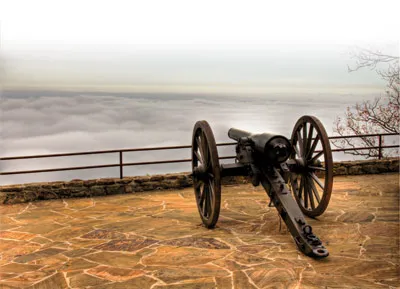
The Union Army of the Cumberland was in the damndest mess Asst. Sec. of War Charles A. Dana had ever seen. “It was wholesale panic,” he wrote in the aftermath of the crushing September 20, 1863 defeat at Chickamauga. The Federal army, under the often brilliant yet erratic Maj. Gen. William S. Rosecrans had streamed back into Chattanooga, Tenn., seemingly on the brink of an even greater disaster. By mid-October, Rosecrans, who it seemed was acting “confused and stunned, like a duck hit on the head,” had been removed, resulting in a major command shake-up. With the appointment of Maj. Gen. Ulysses S. Grant to command the Military Division of the Mississippi, Lincoln sought, as he put it, “to move heaven and earth,” to end the Chattanooga crisis with a major victory.
Despite the high stakes, the story of the Chattanooga Campaign and the incredible attack at Missionary Ridge has remained over the years as one of the most overlooked and misunderstood of all Civil War events. Many consider Chattanooga and Missionary Ridge simply a part of the natural chain of events guided by that military mastermind, Ulysses S. Grant; the reality was anything but.
The strategic importance of Chattanooga — termed by Lincoln a thorn in the Confederacy’s vitals — was indisputable. The industrial town was situated in the great horseshoe bend of the Tennessee River and surrounded by towering mountains and ridges, notably the 600-foot heights of Missionary Ridge. This summit was the Confederate army’s main point of occupation following Chickamauga, from which Confederate Gen. Braxton Bragg established his headquarters and directed the siege he thought would starve out the Yankees. So confident in the ridge’s natural strength was Bragg that no entrenchments were prepared along the crest.
Yet by early November, despite Grant and his army being virtually trapped and reduced to desperation, there were no signs of the Yankees leaving. This wasn’t just a function of Federal tenacity —when Grant had arrived in Chattanooga in late October, he found the Army of the Cumberland all but immobilized. The loss of so many horses and mules to starvation meant there weren’t enough left to move artillery, or even bring vital supplies across the mountain roads from Bridgeport, Ala. While the assault on Brown’s Ferry on the night of October 26–27 opened the so called “cracker line,” Grant knew that it would take time before the full benefits of breaking of the enemy’s river blockade were felt. Chattanooga would take time to benefit from. Yet the substantial flow of food and supplies by river boat now enabled his further planning.
In mid-November Grant boldly sought to take the offensive, both to break the siege and also to wreck the Confederate army. Indeed, while his opponent Bragg was content to react to Grant’s moves, Grant was a commander who sought to manage rather than be managed by events.
The key to Grant’s plans was his trusted friend and subordinate since the days of Shiloh, Maj. Gen. William Tecumseh Sherman, newly promoted to Grant’s old post as commander of the Army of the Tennessee at his superior’s insistence. Sherman’s hardy troops, the victors of Vicksburg now dispatched as reinforcements to Chattanooga, seemed far above the elements of the two other large armies now gathered at Chattanooga. The downtrodden Army of the Cumberland, under Maj. Gen. George Thomas was regarded as the sad-sack loser of Chickamauga. Personally, Grant viewed Thomas with suspicion from their days together at Corinth, Miss.; the plain-spoken, phlegmatic Thomas and the intensively aggressive Grant were on opposite ends of the personality spectrum and neither regarded the other with much joy or appreciation. Maj. Gen. Joseph Hooker’s two corps, hastily dispatched from the East, were held in contempt as “paper collar” soldiers with polished brass buttons who couldn’t handle Robert E. Lee. Thus, as they marched from the Mississippi River to Chattanooga over the span of nearly a month, Sherman’s troops were regarded as the main hope for destroying Bragg’s Confederates.
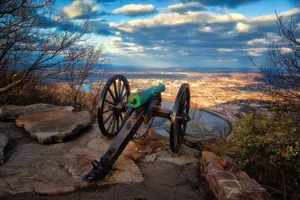
When, on about November 5, he learned that Bragg had detached Longstreet’s Corps — sent west on detail from the Army of Northern Virginia — and sent its 12,000 troops to east Tennessee, Grant was stunned. He wanted to force Bragg to recall Longstreet to Chattanooga, saving Maj. Gen. Ambrose Burnside from facing overwhelming odds at Knoxville. Thomas was ordered to attack the north end of Missionary Ridge, but, with his artillery immobile for want of sufficient animals to move the guns, Thomas did not advance, retorting that the attack was “impracticable – out of the question.”
Grant was embarrassed and angry, deepening his resolve not to trust Thomas and his rag-tag, unreliable army with anything but a secondary role. The day after Sherman arrived in Chattanooga to confer with Grant on November 15, they made a joint reconnaissance of the local region. Sherman readily endorsed Grant’s master plan — Sherman’s main assault would turn Bragg’s flank on north Missionary Ridge, then advance to Chickamauga Station and interfere with or cut off Bragg’s retreat south. “I can do it,” Sherman confidently proclaimed after looking through field glasses at the high hills opposite the mouth of South Chickamauga Creek.
Yet, days later, there was great disappointment. Sherman was delayed by bad weather, bad roads and his own miscalculations. He had ordered his columns to march from Bridgeport, Ala., with wagons and artillery at the end of each division, but this configuration so congested travel that Grant had to postpone the anticipated attack from the November 20 to 22 — and, finally, indefinitely. Sherman was loudly criticized within the army’s inner circle, and was now the man on the spot. Even worse, on November 23, several Rebel deserters reported that Bragg’s army had begun a full retreat the previous night! That many of Bragg’s troops had been seen moving along Missionary Ridge gave the intelligence credibility.
Grant, frustrated and impatient, reacted quickly and set out to immediately determine if Bragg was trying to escape before the last of Sherman’s troops arrived. Thomas was ordered to make a probing reconnaissance from his position in front of Missionary Ridge to see if Bragg was still in force along the heights. Should Bragg be discovered retreating, as it appeared, Sherman would be immediately ordered to cross to the south bank of the Tennessee River in pursuit.
To George H. Thomas, however, advancing against prepared enemy entrenchments was not a routine assignment to be undertaken lightly or with small units. Instead, he ordered a large reconnaissance in force — four full divisions with a total of about 25,000 men — to advance toward the 100-foot knoll in the Chattanooga Valley known as Orchard Knob, where the Rebels had their advanced picket lines. With his skirmishers driven back by overwhelming force, Bragg would redeploy what troops were available, revealing how many Confederates remained and leaving the ever-cautious Thomas with a significant buffer in case of counterattack.
It was, pure and simple, an overreaction to Grant’s orders. Yet, ironically, this reconnaissance began the bizarre sequence of events that led to a final confrontation at Chattanooga.
When, on November 23, Brig. Gen. Thomas J. Wood’s troops advanced after forming on the plain below the Union forts around Chattanooga, Bragg’s soldiers were surprised. Many Rebel pickets had come out of their rifle pits and were watching what they supposed was a Yankee review or inspection. When Wood’s men advanced on the two Alabama regiments present in the vicinity with bayonets gleaming, there was a frantic rush to find cover. Bragg’s generals, watching from atop Missionary Ridge, were also fooled into thinking it was a parade; by the time they formed their men atop Missionary Ridge, the Alabamians had been overrun and Orchard Knob lost.
Initially, Thomas was to return to Chattanooga once the reconnaissance ended, but both he and Grant had been watching from the ramparts of Fort Wood and signal flags quickly wig-wagged a message: “Hold on, don’t come back; you have got too much. Entrench your position.” And so, at the cost of fewer than 200 casualties, the Union had claimed an advanced position halfway across the valley to Missionary Ridge. Grant soon ordered more infantry and artillery forward, and by nightfall the new advanced perimeter was considered secure. It was a lucky break; the small patrol anticipated by Grant would likely have been withdrawn.

Bragg, shaken by the sight of so many Yankees taking position in front of the central ridge where his headquarters were located, made a major revision in his plans. Having previously regarded the primary Union objective as a turning of his left flank on distant Lookout Mountain, he now began to fear an imminent assault on his center at Missionary Ridge. When he had learned of Sherman’s presence near Chattanooga on November 19, Bragg feared Grant was sending these troops upriver to get to his rear. Thus on November 22, he had ordered his best combat commander, Maj. Gen. Patrick Cleburne to take two divisions, 11,000 men, and reinforce Longstreet in east Tennessee, to counter Sherman’s movement in that direction. Now, less than a day later, Bragg recalled Cleburne and called off a suicidal night attack by Brig. Gen. Arthur M. Manigault’s lone brigade on the Yankees’ Orchard Knob position. Finally, Bragg ordered Lt. Gen. William J. Hardee, positioned on the Confederate army’s far left flank along Lookout Mountain, to march with a division and move to the far Confederate right on Missionary Ridge.
When Hardee arrived at his new position, he discovered only a few reserves along the crest in his sector. Thus he divided Brig. Gen. Patton Anderson’s division between the top and bottom of the 600-foot-high ridge, and ordered all artillery removed from the base of the ridge to the top. The attenuated line at the base was largely intended as a buffer force, and would retire to the crest if pressed by the enemy. Bragg so fretted about an assault on central Missionary Ridge that on the morning of November 23 — after more than 60 days spent holding the heights— he finally ordered that breastworks be built along its crest.
Bragg’s actions declared that he would fight the coming battle by responding to the enemy’s initiatives. But Ulysses S. Grant had no intention of assaulting mid-Missionary Ridge. The master plan was to avoid Bragg’s strong middle line and attack the exposed northern end with Sherman’s massive columns.
On November 24, Sherman was finally ready, despite the delay of one of his divisions, trapped by the breaking of a pontoon bridge at Brown’s Ferry. The previous night, Sherman had promised Grant he would advance on the morrow, writing, “No cause on earth will induce me to ask for longer delay.” Indeed, during the predawn hours, Sherman’s troops established a beachhead on the south bank, about six miles above Chattanooga, opposite and beyond Bragg’s far right flank. Utilizing pontoons floated down from North Chickamauga Creek, Sherman’s engineers built a bridge, and a small steamer which also ferried troops across. Within hours, Sherman had 8,000 troops across the river, and about 1:00 p.m. he ordered his columns forward. Advancing in a light rain against minimal opposition, by 3:30 p.m. Sherman’s troops were atop their target hill, said to be the head of Missionary Ridge.
Sherman could hardly believe his luck. By nightfall, the master plan for a big victory seemed assured, and he signaled to Grant that he had carried the very end of Missionary Ridge. It seemed that Grant had cause for celebration: with Sherman seemingly in control of Missionary Ridge all the way to the railroad tunnel, and Lookout Mountain captured by Hooker’s troops, he sent a telegram to Washington, D.C., announcing that his plans were going well.
Bragg, meanwhile, was astounded by the sudden arrival of Sherman’s troops on his far right flank. The northern end of his line was so sparse that only a few cavalry troopers were present to oppose the new threat as it crossed the Tennessee. Only the single brigade of Brig. Gen Marcus J. Wright was available to move into position from Chickamauga Station that afternoon. At about 2:00 p.m., the desperate Bragg ordered Cleburne’s in-transit division to rush to the far right and defend North Missionary Ridge. Although the Irish-born Confederate general hastened his men to the site, by the time they arrived it was near nightfall. Cleburne found Sherman’s men occupying a high hill opposite the end of North Missionary Ridge. With anxious haste, Cleburne prepared that night for what he knew would be a devastating assault the following morning.
That night, the central question among the principal Confederate generals was whether to fight or retreat. Most of Bragg’s principal subordinates opted for a retreat, but at a critical moment in that evening’s council of war, Maj. Gen. John C. Breckinridge reportedly declared that if the Confederate army couldn’t fight to the defend naturally strong Missionary Ridge, “they couldn’t fight anywhere.” Bragg, who some joked might rely on the advice of even a drummer boy in the midst of a crisis, was desperate for a victory and accepted Breckinridge’s advice, against a chorus of protests. This, in effect, set up a remarkable confrontation for November 25 —Cleburne, perhaps the Confederate army’s finest fighting general, against Sherman, Grant’s favorite and the victor of Vicksburg. Yet, the disparity in numbers seemed so unequal as to be no contest: Cleburne had only 4,000 men against Sherman’s 30,000 available troops.
Fighting began at first light and Sherman soon discovered he had made a serious mistake: he did not actually occupy North Missionary Ridge, but an adjacent, detached elevation called Billy Goat Hill. Now, confronted with an unknown quantity of Cleburne’s troops, Sherman became cautious, leading to a series of piecemeal, isolated assaults that failed to bring sufficient force to bear on any specific site. Strong defensive points, accentuated by narrow valleys of access, and limited routes of maneuver helped Cleburne defend against mostly brigade sized attacks. Sherman, aware that Confederate reinforcements had been seen streaming into this sector, was apprehensive of a Confederate counterattack, and held back. About 1:00 p.m. a furious fight was underway for Tunnel Hill, on the western side of the ridge. Here the Chattanooga & Cleveland (Tennessee) Railroad tunnel passed through Missionary Ridge, above which Cleburne had posted most of his artillery. The vicious fighting included an instance during which Cleburne personally led a counterattack against Sherman’s stalled troops, clinging to the hillside below the crest. Cleburne’s valor was rewarded; his bold assault drove the Yankees down the slopes in utter flight.
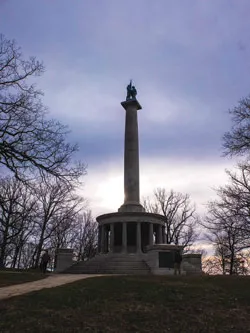
By late afternoon, William Tecumseh Sherman was beaten and distraught, leaving Grant’s main effort hopelessly stalled. Fewer than 10,000 men had participated in Sherman’s isolated series of attacks, but more than 1,200 had become casualties. About 4:00 p.m., the badly shaken Sherman ordered his troops to pull back from the base of North Missionary Ridge and go into bivouac.
Grant and the other Union generals who watched the debacle from Orchard Knob were dismayed and even stunned when they saw Sherman’s troops fleeing down the western side of Tunnel Hill. In response, Hooker was belatedly ordered to move from Lookout Mountain and attack the opposite end of Missionary Ridge, to the south near Rossville Gap. But the burning of a bridge over Chattanooga Creek delayed the movement, and Hooker was nowhere to be seen.
Grant, upset and anxious, turned to Brig. Gen. Thomas Wood, remarking that Sherman was having a hard time, and perhaps something should be done to help him. Wood agreed, and Grant impulsively told him to advance with his own and Philip Sheridan’s divisions from Thomas’s command. By carrying the rifle pits at the base of central Missionary Ridge, pressure on Sherman might be relieved. It was intended only as another demonstration, not a major attack.
Technically, Grant’s impromptu thinking was a blueprint for disaster. By advancing to attack the rifle pits at the base of Missionary Ridge, Thomas’s soldiers would be caught in an untenable situation — even if they captured the rifle pits, they would be trapped under the muzzles of the Rebel guns atop the ridge. Even worse, Grant failed to learn of the true battlefield situation before committing these troops — he expected Sherman to use the breathing room to renew his attack. Sherman, however, had fully disengaged by the time Wood’s men formed.
The situation was bleak: Sherman was defeated on the north, Hooker was floundering in his attempt to reach Bragg’s southern flank and Thomas’s troops were about to take an exposed position where they might be pounded into oblivion, but Grant, remarkably, didn’t know he was beaten.
The need for haste precluded written orders, and the instructions that went out to Thomas’s various brigade and unit commanders were verbal. In the rush and confusion, some Union commanders believed they were to advance to the enemy’s line of rifle pits and halt, whereas others were told only to advance, and some units failed to get any orders at all.
At 3:40 p.m., six signal cannon fired from Orchard Knob, and four divisions of Thomas’s army, about 24,000 men, marched straight for the line of Confederate rifle pits at the base of mid-Missionary Ridge. Although bombarded by about 50 Confederate cannon from atop the ridge, Thomas’s soldiers easily made it to a point just in front of the rifle pits, where they were surprised by an incredible sight.
Most of the Rebels in the lower line of breastworks began running away even before being approached by the oncoming line of blue soldiers. Although some stood fast and were still blazing away, the enemy line was noted to be vacant in spots. Forward units, such as Brig. Gen. William Hazen’s brigade, raced ahead and occupied the partially empty rifle pits with minimal fighting. Only later did the Union soldiers learn that Lt. Gen. William J. Hardee, commanding the Confederate right wing, had previously ordered all units posted at the base of the ridge to retire up the slopes upon the near approach of the enemy. By the time the Federals approached, half of each division was already at the top, leaving the remainder to climb the ridge under fire, with their backs exposed. The chaos, confusion and exhaustion that resulted were anticipated by many of Hardee’s officers, who had protested to no avail. Equally significant, Hardee had ordered all his artillery to the top of the ridge, leaving no basis of support along the lower line.
Their quick and exhilarating victory at the lower rifle pits left most of Thomas’s men believing the Rebels were fleeing in terror. Yet, as they halted at the rifle pits to catch their breath, blasts of canister and the zip of rifle balls foretold of a new danger. The Confederates atop the ridge were shooting down their throats — they were trapped beneath the enemy’s guns. Instantly, soldiers and officers alike knew they could not stay in that exposed and vulnerable position. Impulsively, and in clusters, Thomas’s soldiers dashed ahead for the protection of the slopes and began climbing up the ridge — all without orders.
The excitement of chasing the supposedly beaten enemy up that steep, tangled ridge was for many the thrill of a lifetime. Within about 20 minutes, the first elements of the wave began nearing the top.
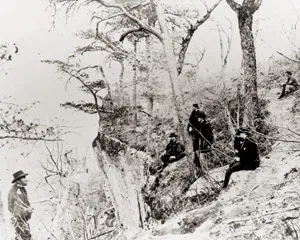
Standing aghast on Orchard Knob, Grant could hardly believe what he was seeing and demanded to know who had ordered the charge. “I don’t know,” replied Thomas. “I didn’t.” Menacingly, Grant then remarked that someone would pay dearly if the assault failed. And having already witnessed the repulse of Sherman’s troops, Grant was justified in his concern. Although several units were ordered back to the rifle pits, it was too late. Thomas’s men were out of control, the Union high command mere bystanders; the charge was unstoppable.
To the Confederates atop Missionary Ridge, it seemed that half the Yankee army was coming at them, and the scattered ranks of their own men retreating up the ridge left the defenders without a clear field of fire. Even worse, most of the Confederate breastworks were at the actual crown of the ridge, rather than lower down on the proper military crest, meaning that Bragg’s men thus couldn’t see the enemy directly in front. Even artillery fire wasn’t effective; the muzzles couldn’t be sufficiently depressed to easily hit the attackers.
Less than half an hour after catapulting out of the rifle pits, the lead elements of two brigades — those of Hazen and Brig. Gen. August Willich — scrambled over the crest and burst among the startled ranks of Col. William F. Tucker’s Miss. Brigade. Their unexpected appearance stampeded Tucker’s men. In a panic, they fled from the prominent spur known as Sharp’s Headquarters. With wild yells, Union troops continued breaking over the crest and rapidly overran Bragg’s artillery and infantry units. Captured cannon were turned against the hard-pressed remaining Rebels, who now had to fight in two directions.
Although reinforcements were sent by desperate Confederate commanders, the crest of the ridge was so narrow there was little room for maneuver. The Rebel soldiers were swiftly crowded off the ridge, scattering down along the eastern slopes as more and more of Thomas’s soldiers broke over the crest. In the spreading panic and terror, what was once thought to be an impregnable Confederate line atop Missionary Ridge was swiftly destroyed.
To complete the rout, Hooker’s columns suddenly appeared on the southern end of Missionary Ridge, easily overwhelming the few defenders there. Only Cleburne’s valiant soldiers and some of Hardee’s men held the far right flank intact, enabling the floodtide of beaten Confederates to gather at Chickamauga Station before beginning their retreat to Dalton, Ga. Confederate losses were staggering: 40 pieces of artillery and more than 4,000 men captured. By comparison, Grant’s forces suffered only 5,800 total casualties.
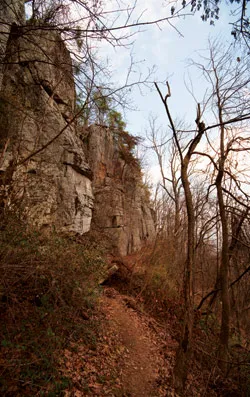
Why had the Confederates suffered such a humiliating defeat on Missionary Ridge? It was not the “military miracle” heralded by some observers. Aside from the obvious tactical mistakes, the basic error was really conceptual; Bragg had planned for a siege, not a frontal assault on his strongest line. This lack of anticipation had resulted in fatal mistakes. Despite holding Missionary Ridge for two months, breastworks, cleared fields of fire, artillery emplacements and even the strategic placement of munitions were neglected until the last moment. Because Bragg expected to starve the enemy from Chattanooga, his own troops had been neglected, transferred, underfed and sent away in a series of detachments.
At the time, however, there was much head-scratching among the Union generals. Somehow George H. Thomas’s troops had won a battle against all odds. The men knew that frontal attacks against well-defended positions almost always failed. Yet the circumstances that day wouldn’t allow for careful logic or practicality. Thomas’s veterans had been placed in a situation that was not a question of tactics, but rather a matter of survival and saved the day when all seemed lost. The irony of these much maligned soldiers having won the battle was soon obscured.
For the Confederates, explaining the debacle was a painful impossibility. Blame in the press was centered on Bragg, who resigned on November 30 —later re-emerging as Jefferson Davis’s personal military adviser. In a larger sense, the loss of Chattanooga proved to be a milestone in the path of doom for the Confederacy. With its fall, the specter of invasion, economic ruin, diminishing resources and irreplaceable manpower losses loomed ever larger.
In the final analysis, however, popular history has all but obscured the essential story. The plans of Grant, Sherman, Thomas, Sheridan, Hooker and others paled in comparison to the truly decisive factor: the pluck of the common soldier. Indeed, those who had fought at Missionary Ridge had discovered a supreme human wisdom and ultimate truth — the indomitable spirit that exists only in one’s heart is often the most important element of all.
Help the Trust save 161 acres across consequential Western Theater battles — Fort Heiman and Fort Henry, Brown’s Ferry/Chattanooga, Spring Hill, and...





